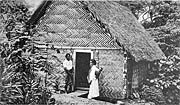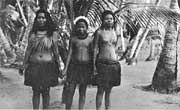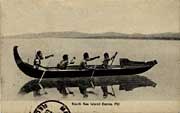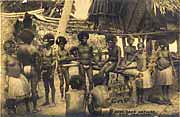|
"Fiji 'Meke-Meke' (national dance". [Incorrect. This is NOT actually a Fijian meke, see description]. Unused. Tuck's Post Card. "Oilette" [Regd.] postcard 7601. Publisher Raphael Tuck & Sons Ltd., By Appointment. Art publishers to Their Majesties the King & Queen. This is one of six "Oilettes" produced by Tuck in the early 1900s, reproducing oil-paintings done over photographs taken in 1879 by B.G.Besse. His negatives were sold successively to A.Stevens and the Dufty Brothers, via whom they may have been sold to Tuck (Stephenson p.113-15). On the reverse is the caption: "Meke-Meke. This dance is a great feature of the national life or great ceremonials of the Fiji islanders. It appears in various forms according to the locality in which it is performed, but the general idea is always the same, that of a measured series of quaint movements to the barbaric music of the home-made instruments and weird chanting of other members of the tribe." In fact it was neither Fijian nor a meke, though it did take place in Fiji. Incidentally, the reduplication meke-meke is Plantation Pidjin Fijian in wide use on plantations and among Fiji's non-indigenous population in the mid-late 1800s — in Standard Fijian the term is simply meke. Stephenson (p.115) records of this card that it "is based on a photograph taken by Besse on the island of Mago where, at the time, a sugar mill was in operation. The dancers were indentured Melanesian labourers" [which could cover the Solomons, Vanuatu, and the Line Islands, as well as some Polynesian outliers: see my book review]. That it is not Fijian is evidenced by the fact that the dancers face inward and form a concentric mass, whereas invariably in meke they form up in ranks facing the onlooker, either sitting or standing. The dance shown here appears to be a form of club dance, since many of the men have clubs on their shoulders. The discoid throng calls to mind the kecak or monkey-dance of Bali. At a personal level, this has the added interest that my grandfather managed Mago plantation for a time around 1912, about 30 years after Besse would have taken this photograph. |
|
|
"Native women Fiji". Unused. Co-Op Copyright #38217N. Undated, but the number suggests a 1938 publication date. That does not, of course, preclude the photograph having been taken years, even decades, earlier. These women are certainly not ethnic Fijians, and from their appearance and dress I would surmise are from Micronesia somewhere rather than from Rotuma (which was and remains still administratively part of Fiji). It was common for postcard sellers in Fiji to use female models from elsewhere, mostly Fiji's Polynesian neighbours Tonga and Samoa, but also Micronesia, the fairness of the models believed to be more attractive to Western eyes than indigenous Fijian women. |
|
|
"Solomon Islanders Dance" Publisher A.M. Brodziak & Co., Suva-Fiji. Unused and undated, but undivided back indicates it as around the turn of the 19th-20th centuries. Though it does not say so, it is reasonable to assume that this photograph was taken in Fiji, and shows a group of Solomon Islands labourers, of whom thousands were imported to Fiji to work in plantations, notionally as indentured labour, but relatively few were ever repatriated (see book review concerning this matter and its present consequences). |
|
 |
" Fijians at home" [Actually Solomon Islanders] Publisher Gus Arnold, Suva-Fiji. Used but postmark illegible. Undivided back indicates it as between the late 19th century and the first 5 years of the 20th century, consistent with Arnold's period of operation. The label on this photo is totally erroneous. The plaited bamboo, the pattern on the front of the gable, and the carved decorative features, all mark this clearly as a Solomon Islander's home. |
|
"South Sea Island Canoe, Fiji". 1912 This is a Solomon Islands canoe, and from their accoutrements the paddlers are clearly also Solomon Islanders (see remarks for the previous picture). Such a canoe was evidently not unique in Fiji, a more elaborately ornamented one, but with a similar high stern, being also pictured in Suva Harbour in "The Cyclopedia of Fiji" (1907) p.67. Stamp removed but Suva postmark visible, as well as receipt postmark Kansas. Addressed to Mr Geo BL. Brent, Leon, Kansas. Message reads "Suva, Fiji Aug 23, '12. Arrived today on time fine trip business good, Hope this will find you all well. C.Brent." The multi-cultural combination of a Kansas businessman sending a Fiji postcard of a Solomons canoe is intriguing. |
|
|
"East Cape Natives. Brit. New Guinea" Not Fijian, but sent to Fiji. Postmarked on verso "Daru W.D. 27 Nov 07" and two other postmarks 8 Dec 07 and Jan 08. On face, postmarked "Sydney Dec12 1907". Addressed to W.Ewins Esq,. Resident Magistrate. c/o Colonial Sec. Suva. Fiji. Overwritten Kadavu, Tavuki. [W.J. was my grandfather, pictured at the top of this webpage. From March 26 1907 to 1911 or 1912, with brief interludes in other provinces, he was Stipendiary Magistrate, Inspector of Native Taxes, Inspector of Immigrants, and postmaster, Kadavu. From there he moved to Vanua Balavu, Lau.] Typed message reads: "Daru. W.D. Papua. 27.11.07. Marian, Nance and self send best wishes for a happy Xmas and prosperous new year when 1908 makes its appearance. Marian is leaving for Leura N.S.W. tomorrow. Her address is to be "Lynton", Leura, Blue Mountains, N.S.Wales. Hope you and yours are all well." Signed A.H.J. |




